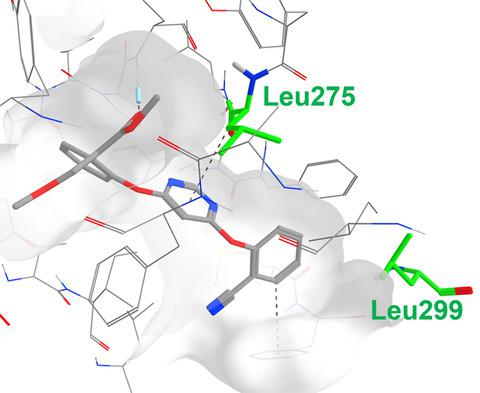当前位置:
X-MOL 学术
›
Plant Pathol.
›
论文详情
Our official English website, www.x-mol.net, welcomes your
feedback! (Note: you will need to create a separate account there.)
Amino acid substitutions responsible for different QoI and SDHI sensitivity patterns in Puccinia horiana, the causal agent of chrysanthemum white rust
Plant Pathology ( IF 2.3 ) Pub Date : 2020-10-19 , DOI: 10.1111/ppa.13298 Yuichi Matsuzaki 1 , Toshiyuki Harada 1 , Fukumatsu Iwahashi 1
Plant Pathology ( IF 2.3 ) Pub Date : 2020-10-19 , DOI: 10.1111/ppa.13298 Yuichi Matsuzaki 1 , Toshiyuki Harada 1 , Fukumatsu Iwahashi 1
Affiliation

|
Quinone outside inhibitors (QoIs) and succinate dehydrogenase inhibitors (SDHIs) are major groups of agricultural fungicides. However, resistance to some of these fungicides has been reported in a Japanese population of Puccinia horiana, the causal agent of chrysanthemum white rust disease. Because their mechanisms are not well understood, we investigated the existence of mutations in QoI and SDHI target protein‐encoding genes. Eight out of nine isolates from cultivated chrysanthemum carried L275F and L299F amino acid substitutions in cytochrome b, the target protein of QoIs. These isolates showed 23‐ and 17‐fold higher EC50 values for the QoI fungicides azoxystrobin and kresoxim‐methyl, respectively, in basidiospore germination inhibitory tests, while they were hypersensitive to another QoI, famoxadone. All nine isolates were resistant to SDHI oxycarboxin and carried the I88F substitution in SdhC. This substitution was orthologous to the SdhC‐I86F substitution found in some Brazilian isolates of the soybean rust fungus, Phakopsora pachyrhizi, showing reduced sensitivity to some SDHIs. Although the rarity of wild‐type sensitive isolates, the subsequent limited number of comparisons between wild types and mutants, and a difficulty in applying reverse genetic analysis to this obligate parasite, are obstacles in making definitive conclusions, L275F and L299F in cytochrome b and SdhC‐I88F are suspected to be responsible for the different patterns of sensitivity to QoI and for oxycarboxin‐resistance in P. horiana, respectively.
中文翻译:

菊花白锈病的病原体——Puccinia horiana中的氨基酸替代导致不同的QoI和SDHI敏感性模式
醌外抑制剂(QoIs)和琥珀酸脱氢酶抑制剂(SDHIs)是农业杀菌剂的主要类别。然而,在日本的Puccinia horiana(菊花白锈病的病因)种群中,据报道对其中某些杀真菌剂产生抗药性。由于尚未充分了解它们的机制,因此我们研究了QoI和SDHI目标蛋白编码基因中突变的存在。栽培菊花的9个分离株中有8个在QoIs的靶蛋白细胞色素b中具有L275F和L299F氨基酸取代。这些分离株的EC 50分别高出23倍和17倍QoI杀真菌剂嘧菌酯和克雷索肟的数值分别在担子孢子萌发抑制试验中显示,而它们对另一种QoI则是法莫沙酮过敏。所有九种分离株均对SDHI氧羧化酶具有抗性,并在SdhC中进行了I88F取代。这种替代是直系同源在大豆锈病真菌的一些分离株巴西发现SDHC-I86F取代豆薯层锈菌,显示出减小到一定SDHIs灵敏度。尽管野生型敏感菌株不多见,但随后野生型和突变体之间比较的数量有限,并且难以对这种专性寄生虫进行反向遗传分析,这仍然难以做出明确的结论,即细胞色素b中的L275F和L299F怀疑SQC和SdhC-I88F对QoI的不同敏感性模式和P中的氧羧抗性负责。horiana。
更新日期:2020-10-19
中文翻译:

菊花白锈病的病原体——Puccinia horiana中的氨基酸替代导致不同的QoI和SDHI敏感性模式
醌外抑制剂(QoIs)和琥珀酸脱氢酶抑制剂(SDHIs)是农业杀菌剂的主要类别。然而,在日本的Puccinia horiana(菊花白锈病的病因)种群中,据报道对其中某些杀真菌剂产生抗药性。由于尚未充分了解它们的机制,因此我们研究了QoI和SDHI目标蛋白编码基因中突变的存在。栽培菊花的9个分离株中有8个在QoIs的靶蛋白细胞色素b中具有L275F和L299F氨基酸取代。这些分离株的EC 50分别高出23倍和17倍QoI杀真菌剂嘧菌酯和克雷索肟的数值分别在担子孢子萌发抑制试验中显示,而它们对另一种QoI则是法莫沙酮过敏。所有九种分离株均对SDHI氧羧化酶具有抗性,并在SdhC中进行了I88F取代。这种替代是直系同源在大豆锈病真菌的一些分离株巴西发现SDHC-I86F取代豆薯层锈菌,显示出减小到一定SDHIs灵敏度。尽管野生型敏感菌株不多见,但随后野生型和突变体之间比较的数量有限,并且难以对这种专性寄生虫进行反向遗传分析,这仍然难以做出明确的结论,即细胞色素b中的L275F和L299F怀疑SQC和SdhC-I88F对QoI的不同敏感性模式和P中的氧羧抗性负责。horiana。











































 京公网安备 11010802027423号
京公网安备 11010802027423号